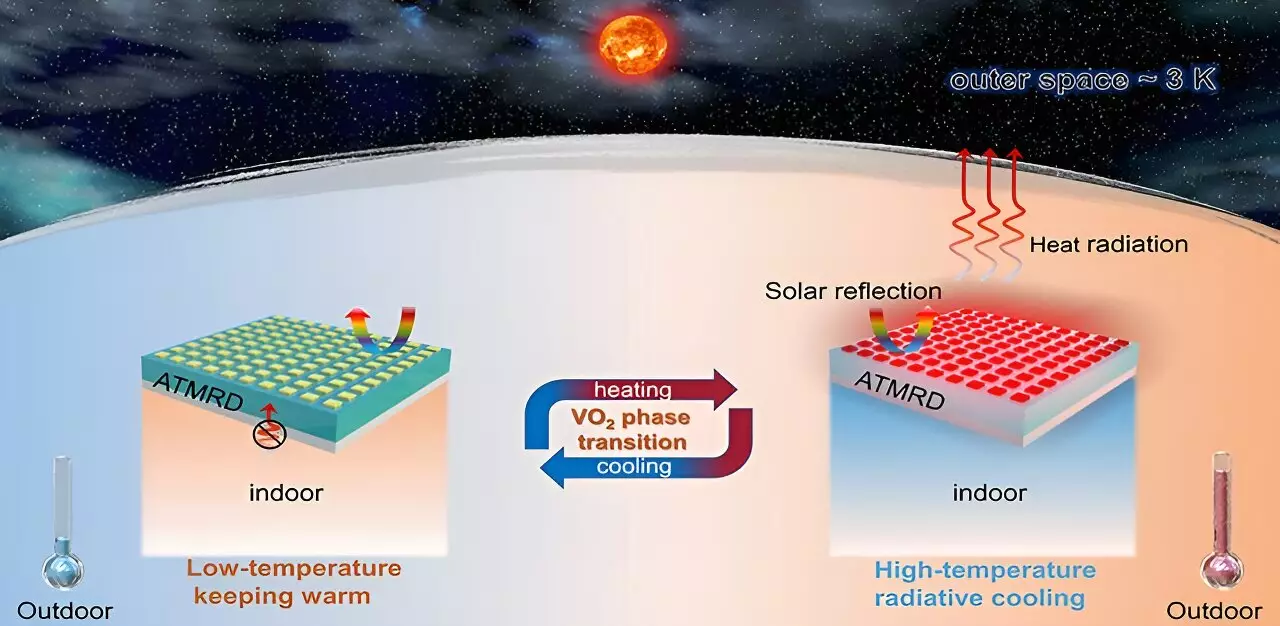As the effects of climate change become increasingly severe, urgent responses are needed to address the dual challenges of energy consumption and conservation. The quest for sustainable energy solutions has brought a focus on various innovative technologies, among which passive radiative cooling stands out. This promising method leverages natural phenomena to allow objects to release heat into the vast expanse of space without needing external power sources. While the potential appears vast, several challenges still inhibit its widespread application, notably the static properties of many existing radiative cooling materials.
The Problem with Static Cooling Materials
Most currently available radiative cooling materials exhibit static emissivity – a characteristic that, while beneficial in conditions of high ambient temperatures, results in inefficiencies during cold weather conditions. This phenomenon leads to an “overcooling” effect, where excessive cooling forces heating systems to work harder, ultimately increasing energy consumption. The traditional materials utilized in radiative cooling systems fail to adapt to fluctuating ambient temperatures, a critical challenge for effective thermal management. The need for innovative solutions that can dynamically modulate cooling properties has heightened, igniting interest in thermochromic phase-change materials.
Advancements in Thermochromic Materials
Thermochromic materials present an exciting realm of opportunity for researchers aiming to create adaptive cooling technologies. These materials can change their thermal properties based on temperature, thus addressing the issue of overcooling by matching their performance to environmental conditions. A groundbreaking development in this field comes from a team at the Beijing Institute of Technology, who are pioneering advancements in temperature-adaptive radiative cooling devices. This innovation signifies a potential turning point in how passive cooling systems manage energy.
The Role of Vanadium Dioxide
At the heart of this research is vanadium dioxide (VO2), a remarkable material known for its ability to transition between various thermal radiation states. The latest designs were unveiled in a paper published in Advanced Photonics, where the team introduced a novel device termed the Temperature-Adaptive Metasurface Radiative Cooling Device (ATMRD). The ATMRD comprises a carefully optimized metasurface featuring an array of VO2 squares. This design aims to strike an optimal balance between thermal emissivity and solar absorptance – a strategic improvement that has far-reaching implications for energy management.
The advancements claimed by the ATMRD are significant. With a solar absorptance of just 27.71%—a reduction of 7.54% compared with earlier models—and a thermal emissivity of 0.85 at elevated temperatures—an increase of 13.3%—the new device exhibits remarkable efficiency. Moreover, it demonstrates a 20% enhancement in its modulating capacities compared to predecessors. This combination of reduced solar absorption while maximizing emissivity positions the ATMRD as a critical player in sustainable thermal management.
Prof. Jingbo Li, the lead researcher of the project, articulates the significance of these findings: “By integrating a temperature-adaptive metasurface with vanadium dioxide, we have significantly improved the efficiency of radiative cooling technologies.” The implications of this research extend beyond experimental labs; they harbor the potential to reduce reliance on inefficient heating systems, contributing to energy conservation, economic savings, and diminished environmental impacts.
The exploratory nature of this research also unveils further avenues in the thermal management domain, supplying vital insights into the optimization of geometric parameters in superstructures. As researchers continue to delve into the interactions and mechanisms behind these materials, the potential for greater efficiency and effectiveness in cooling solutions will likely continue to expand.
The introduction of advanced materials and innovative design techniques in the realm of passive radiative cooling could reshape our approach to energy conservation. The advancements being made, particularly through the integration of adaptive materials like VO2, may provide new pathways toward sustainable thermal management solutions. As we stand at a crossroads in energy usage, the thoughtful advancement of these technologies signals a future where energy efficiency is paramount, paving the way for reduced greenhouse gas emissions and a more sustainable world.


Leave a Reply